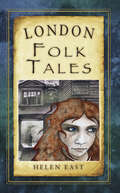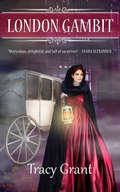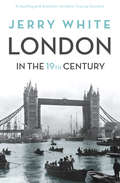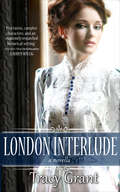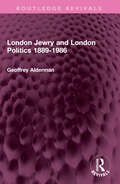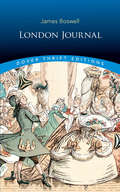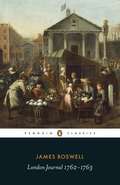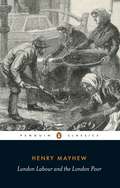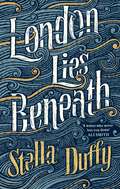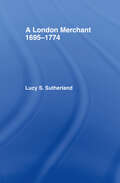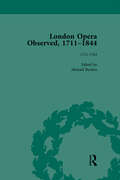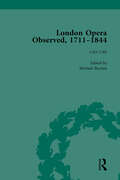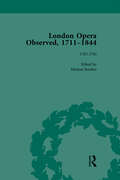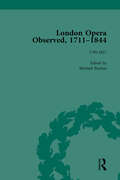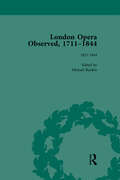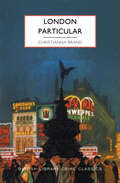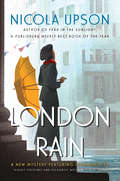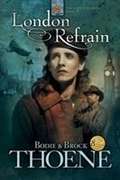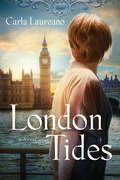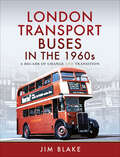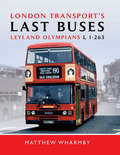- Table View
- List View
London Folk Tales (Folk Tales: United Kingdom)
by Helen EastLondon is a world unto itself; an outrageous, quirky and diverse microcosm where all walks of life cross paths, their languages jostling and mingling – and there are tales whichever way you turn. Now thirty of the best, drawn from oral history and newly recorded local reminiscence, as well as folk sources and written texts, have been brought to life by a mistress of storytelling. Here you will find Dick Whittington alongside the patron saint of cobblers, a royal rat rubbing shoulders with the Maid Uncumber, and fish that decide destinies. Revisit old friends and discover new ones in this wonderful selection of London folk tales – as light and dark, and as full of unexpected twists, as the streets of London itself.
London Gambit (A Malcolm & Suzanne Rannoch Historical Mystery #11)
by Tracy GrantA Malcolm & Suzanne Rannoch Historical Mystery Book 11 On a moonlit London night, Suzanne Rannoch slips away from a glittering Mayfair party to assist a wounded man who has escaped Paris one step ahead of Royalist pursuit. In fever-wracked delirium, the man warns Suzanne of a plot to rescue Napoleon Bonaparte--a plot that could bring chaos to Suzanne's world, for though now married to the grandson of a British duke, she was once an agent for Bonaparte...Before she can ask more questions, the mysterious man disappears into the London night. That same evening, Suzanne's husband Malcolm, himself a former spy for Britain, is summoned to the warehouse of a shipping company where a thief has been knifed to death. Beside the body is a secret compartment, but whatever the compartment contained is gone. These two seemingly unconnected incidents prove to be the opening gambit in a deadly game that will test the Rannochs' skill, strain their divided loyalties to Britain and France, and entangle not only fellow agents and spymasters, but their friends and family. The stakes are their security, their marriage, their very lives. "Shimmers like the finest salons in Vienna." --Deborah Crombie "Meticulous, delightful, and full of surprises." --Tasha Alexander "Glittering balls, deadly intrigue, sexual scandals. . .the next best thing to actually being there!"-- Lauren Willig "A superb storyteller."-- Deanna Raybourn
London In The Nineteenth Century: 'A Human Awful Wonder of God'
by Jerry WhiteJerry White's London in the Nineteenth Century is the richest and most absorbing account of the city's greatest century by its leading expert.London in the nineteenth century was the greatest city mankind had ever seen. Its growth was stupendous. Its wealth was dazzling. Its horrors shocked the world. This was the London of Blake, Thackeray and Mayhew, of Nash, Faraday and Disraeli. Most of all it was the London of Dickens. As William Blake put it, London was 'a Human awful wonder of God'.In Jerry White's dazzling history we witness the city's unparalleled metamorphosis over the course of the century through the daily lives of its inhabitants. We see how Londoners worked, played, and adapted to the demands of the metropolis during this century of dizzying change. The result is a panorama teeming with life.
London Interlude (The Rannoch Fraser Mysteries #2)
by Tracy GrantA Malcolm & Suzanne Rannoch Historical Mystery Novella A year and a half after entering her unusual marriage of convenience to British attaché and intelligence agent, Malcolm Rannoch, Suzanne Rannoch pays her first visit to her husband's home. England: the country her husband fled for reasons she does not fully understand; the country Suzanne has secretly spent the last five years fighting against as a French spy. The trip takes Suzanne and her husband to the heart of London society--the world Malcolm grew up in. A glamorous labyrinth of unwritten rules and unvoiced codes. Yet the glittering ballrooms of London are not free of the intrigues of the Napoleonic Wars. The search for stolen papers that could tip the international balance of power pits Malcolm and Suzanne against each other. Suzanne faces a stark choice between her loyalty to her cause and her love for the man she married--in order to spy on him. "Shimmers like the finest salons in Vienna." --Deborah Crombie "Meticulous, delightful, and full of surprises." --Tasha Alexander "Glittering balls, deadly intrigue, sexual scandals. . .the next best thing to actually being there!"--Lauren Willig "A superb storyteller."--Deanna Raybourn
London Jewry and London Politics 1889-1986 (Routledge Revivals)
by Geoffrey AldermanFirst Published in 1989 London Jewry and London Politics 1889-1986 is a study of the relationship between the London Jewish community, the London County Council, and the Greater London Council. Geoffrey Alderman draws on a wealth of primary and secondary material to illuminate a dialogue that began, a hundred years ago, in a mood of great optimism and co-operation, but which ended, in the early 1980s, in a welter of insults and antagonisms. Alderman adopts a chronological approach, looking first at the Jewish involvement in London government prior to the establishment of the London County Council in 1889. He then analyses the contribution made by London Jewry to the periods of progressive control and conservative rule. With the arrival of Jewish immigrants from Eastern Europe the nature of the Jewish electorate underwent considerable change and Alderman describes how the government exploited prejudice against the Jewish community causing LCC to adopt blatantly antisemitic policies. The Labour victory of 1934 was in part due to the Jewish vote, but the period of Labour rule was a disappointment and an anticlimax. This illuminating account of hundred years is an essential read for scholars and researchers of British history.
London Journal (Dover Thrift Editions)
by James BoswellEven if James Boswell hadn't written the The Life of Johnson, he would be famous for this memoir of eighteenth-century London life. Boswell arrived in the great metropolis from his native Edinburgh in 1762, and he kept a daily journal of his nine-month sojourn. Bawdy, witty, and brimming with fascinating details, the accounts range from his illicit encounters with prostitutes to his momentous meeting with Samuel Johnson. Boswell's London diary disappeared for 150 years, finally turning up in the 1920s as the literary find of the twentieth century. Unlike his other journals, it escaped nineteenth-century bowdlerization, allowing the author's voice to emerge with strikingly modern candor. Boswell writes frankly of his struggles with depression and his sexual obsessions. His painstaking records of the lively repartee of his mentor's literary circle formed the backbone of The Life of Johnson, and just as that book proved him a worthy biographer, so this one shows him an equally captivating subject.
London Journal 1762-1763 (Penguin Classics)
by James BoswellEdinburgh-born James Boswell, at twenty-two, kept a daily diary of his eventful second stay in London from 1762 to 1763. This journal, not discovered for more than 150 years, is a deft, frank and artful record of adventures ranging from his vividly recounted love affair with a Covent Garden actress to his first amusingly bruising meeting with Samuel Johnson, to whom Boswell would later become both friend and biographer. The London Journal 1762-63 is a witty, incisive and compellingly candid testament to Boswell's prolific talents.
London Journal 1762-1763 (The\yale Editions Of The Private Papers Of James Boswell Ser.)
by James BoswellEdinburgh-born James Boswell, at twenty-two, kept a daily diary of his eventful second stay in London from 1762 to 1763. This journal, not discovered for more than 150 years, is a deft, frank and artful record of adventures ranging from his vividly recounted love affair with a Covent Garden actress to his first amusingly bruising meeting with Samuel Johnson, to whom Boswell would later become both friend and biographer. The London Journal 1762-63 is a witty, incisive and compellingly candid testament to Boswell's prolific talents.
London Labour and the London Poor: A Cyclopædia Of The Condition And Earnings Of Those That Will Work, Those That Cannot Work, And Those That Will Not (London Labour And The London Poor - 4-volume Set Ser.)
by Henry MayhewLondon Labour and the London Poor originated in a series of newspaper articles written by the great journalist Henry Mayhew between 1849 and 1850. A dozen years later, it had grown into the fullest picture we have of labouring people in the world's greatest city in the nineteenth century: a four volume account of the hopes, customs, grievances and habits of the working-classes that allows them to tell their own stories. Combining practicality with compassion, Mayhew worked unencumbered by political theory and strove solely to report on the lives of the London poor, their occupations and trades. This selection shows how well he succeeded. From costermongers to ex-convicts, from chimney-sweeps to vagrants, the underprivileged of London are uniquely brought to life - their plight expressed through a startling blend of first person accounts, Mayhew's perceptions, and sharp statistics.
London Lies Beneath
by Stella DuffyBased on a true story, London Lies Beneath is a compelling historical novel from the award-winning writer Stella Duffy.'As gloriously alive as the turn of the century south London streets it portrays' REDIn August 1912, three friends set out on an adventure. Two of them come home. Tom, Jimmy and Itzhak have grown up together in the crowded slums of Walworth. All three boys are expected to follow their father's trades and stay close to home. But Tom has wider dreams. So when he hears of a scouting trip, sailing from Waterloo to Sheppey and the mouth of the Thames - he is determined to go. And Itzhak and Jimmy go with him.Inspired by real events, this is the story of three friends, and a tragedy that will change them for ever. It is also a song of south London, of working class families with hidden histories, of a bright and complex world long neglected. London Lies Beneath is a powerful and compelling novel, rich with life and full of wisdom.'Vivid and full of heart, Duffy's new novel is a fitting hymn to the city that inspired it' FINANCIAL TIMES'A paean not just to South London, but to a vanished way of working-class life . . . Duffy's narrative is as fluid as a costermonger's patter, carrying the reader along' DAILY MAIL
London Local Trains in the 1950s and 1960s
by Kevin McCormackThis remarkable colour album of 1950s and 1960s images covers non-express trains working in and out of London termini, along with a selection of feeder services operating in roughly a 40 mile radius of the Capital. The trains featured are therefore semi-fast passenger, suburban passenger and freights. The advantage of casting the net beyond services in and out of London itself is to increase the variety of locomotive types and diesel/electric units featured, making the book a thoroughly interesting read.Throughout, photographs with identifiable landmarks, for example stations and signal boxes, are used wherever possible. Furthermore, every effort has been made to show a wealth of material which has never been seen before.London Local Trains in the 1950s and 1960s is an in-depth and well-researched account of the London railway scene, that meticulously charts their progress throughout the mid-twentieth century.
London Merchant 1695-1774: A London Merchant
by Lucy Stuart SutherlandFirst published in 1962. Routledge is an imprint of Taylor & Francis, an informa company.
London Night and Day, 1951
by Old House BooksThis unusual and entertaining guide to the capital gives a snapshot of the best places to visit. Arranged by hour of the day, it takes the reader on a journey around 1950s London, from your morning walk to your visit to the Turkish Bath and late-night taxi home. Includes recommended restaurants (many of which still exist), the best stately homes to visit, a tour of the Thames and how to cope with the noise and dirt of a trip to the capital.
London Opera Observed 1711-1844, Volume I: 1711-1763
by Michael BurdenThe thrust of these five volumes is contained in their title, London Opera Observ’d. It takes its cue from the numerous texts and volumes which — during the seventeenth, eighteenth and nineteenth centuries — used the concept of ‘spying’ or ‘observing’ by a narrator, or rambler, as a means of establishing a discourse on aspects of London life. The material in this five-volume reset edition examines opera not simply as a genre of performance, but as a wider topic of comment and debate. The stories that surrounded the Italian opera singers illuminate contemporary British attitudes towards performance, sexuality and national identity. The collection includes only complete, published material organised chronologically so as to accurately retain the contexts in which the original readers encountered them — placing an emphasis on rare texts that have not been reproduced in modern editions. The aim of this collection is not to provide a history of opera in England but to facilitate the writing of them or to assist those wishing to study topics within the field. Headnotes and footnotes establish the publication information and provide an introduction to the piece, its author, and the events surrounding it or which caused its publication. The notes concentrate on attempting to identify those figures mentioned within the texts. The approach is one of presentation, not interpretation, ensuring that the collection occupies a position that is neutral rather than polemical.
London Opera Observed 1711-1844, Volume II: 1763-1782
by Michael BurdenThe thrust of these five volumes is contained in their title, London Opera Observ’d. It takes its cue from the numerous texts and volumes which — during the seventeenth, eighteenth and nineteenth centuries — used the concept of ‘spying’ or ‘observing’ by a narrator, or rambler, as a means of establishing a discourse on aspects of London life. The material in this five-volume reset edition examines opera not simply as a genre of performance, but as a wider topic of comment and debate. The stories that surrounded the Italian opera singers illuminate contemporary British attitudes towards performance, sexuality and national identity. The collection includes only complete, published material organised chronologically so as to accurately retain the contexts in which the original readers encountered them — placing an emphasis on rare texts that have not been reproduced in modern editions. The aim of this collection is not to provide a history of opera in England but to facilitate the writing of them or to assist those wishing to study topics within the field. Headnotes and footnotes establish the publication information and provide an introduction to the piece, its author, and the events surrounding it or which caused its publication. The notes concentrate on attempting to identify those figures mentioned within the texts. The approach is one of presentation, not interpretation, ensuring that the collection occupies a position that is neutral rather than polemical.
London Opera Observed 1711-1844, Volume III: 1783-1792
by Michael BurdenThe thrust of these five volumes is contained in their title, London Opera Observ’d. It takes its cue from the numerous texts and volumes which — during the seventeenth, eighteenth and nineteenth centuries — used the concept of ‘spying’ or ‘observing’ by a narrator, or rambler, as a means of establishing a discourse on aspects of London life. The material in this five-volume reset edition examines opera not simply as a genre of performance, but as a wider topic of comment and debate. The stories that surrounded the Italian opera singers illuminate contemporary British attitudes towards performance, sexuality and national identity. The collection includes only complete, published material organised chronologically so as to accurately retain the contexts in which the original readers encountered them — placing an emphasis on rare texts that have not been reproduced in modern editions. The aim of this collection is not to provide a history of opera in England but to facilitate the writing of them or to assist those wishing to study topics within the field. Headnotes and footnotes establish the publication information and provide an introduction to the piece, its author, and the events surrounding it or which caused its publication. The notes concentrate on attempting to identify those figures mentioned within the texts. The approach is one of presentation, not interpretation, ensuring that the collection occupies a position that is neutral rather than polemical.
London Opera Observed 1711-1844, Volume IV: 1799-1821
by Michael BurdenThe thrust of these five volumes is contained in their title, London Opera Observ’d. It takes its cue from the numerous texts and volumes which — during the seventeenth, eighteenth and nineteenth centuries — used the concept of ‘spying’ or ‘observing’ by a narrator, or rambler, as a means of establishing a discourse on aspects of London life. The material in this five-volume reset edition examines opera not simply as a genre of performance, but as a wider topic of comment and debate. The stories that surrounded the Italian opera singers illuminate contemporary British attitudes towards performance, sexuality and national identity. The collection includes only complete, published material organised chronologically so as to accurately retain the contexts in which the original readers encountered them — placing an emphasis on rare texts that have not been reproduced in modern editions. The aim of this collection is not to provide a history of opera in England but to facilitate the writing of them or to assist those wishing to study topics within the field. Headnotes and footnotes establish the publication information and provide an introduction to the piece, its author, and the events surrounding it or which caused its publication. The notes concentrate on attempting to identify those figures mentioned within the texts. The approach is one of presentation, not interpretation, ensuring that the collection occupies a position that is neutral rather than polemical.
London Opera Observed 1711-1844, Volume V: 1821-1844
by Michael BurdenThe thrust of these five volumes is contained in their title, London Opera Observ’d. It takes its cue from the numerous texts and volumes which — during the seventeenth, eighteenth and nineteenth centuries — used the concept of ‘spying’ or ‘observing’ by a narrator, or rambler, as a means of establishing a discourse on aspects of London life. The material in this five-volume reset edition examines opera not simply as a genre of performance, but as a wider topic of comment and debate. The stories that surrounded the Italian opera singers illuminate contemporary British attitudes towards performance, sexuality and national identity. The collection includes only complete, published material organised chronologically so as to accurately retain the contexts in which the original readers encountered them — placing an emphasis on rare texts that have not been reproduced in modern editions. The aim of this collection is not to provide a history of opera in England but to facilitate the writing of them or to assist those wishing to study topics within the field. Headnotes and footnotes establish the publication information and provide an introduction to the piece, its author, and the events surrounding it or which caused its publication. The notes concentrate on attempting to identify those figures mentioned within the texts. The approach is one of presentation, not interpretation, ensuring that the collection occupies a position that is neutral rather than polemical.
London Particular (British Library Crime Classics)
by Christianna BrandFirst published in 1952, London Particular was Christianna Brand's favorite among her own books, and it remains a fast-paced and witty masterpiece of the genre, showing off the author's signature flair for the ruthless twist. This edition includes an introduction by CWA Diamond Dagger and Edgar® Award–winning author Martin Edwards."You have to reach for the greatest of the Great Names (Agatha Christie, John Dickson Carr, Ellery Queen) to find Christianna Brand's rivals in the subtleties of the trade."—Anthony Boucher in the New York TimesNight falls in the capital, and a "London particular" pea-souper fog envelops the city. In Maida Vale, Rose and her family doctor Tedward struggle through the dark after a man has telephoned from Rose's house, claiming to have been attacked. By the time they arrive, the victim, Raoul Vernet, is dead. The news he brought from Switzerland for Rose's mother has died with him.Arriving to the scene, Inspector Cockrill faces a fiendish case with seven suspects who could have murdered their guest—family members and friends with alibis muddled by the suffocating fog and motives wrapped in mystery. Now, the race is on to find the truth before the killer strikes again.
London Rain: A New Mystery Featuring Josephine Tey
by Nicola UpsonIntrepid writer and amateur sleuth Josephine Tey returns in this sixth installment of Nicola Upson's popular series--perfect for fans of Agatha Christie's Hercule Poirot and Jaqueline Winspear's Maisie Dobbs--that unfolds in 1930s London as England prepares to crown a new king.London, 1937. Following the gloomy days of the abdication of King Edward VIII, the entire city is elated to welcome King George. Just one of the many planned festivities for the historic coronation is a BBC radio adaptation of Queen of Scots, and the original playwright, Josephine Tey, has been invited to sit in on rehearsals.Soon, however, Josephine gets wrapped up in another sort of drama. The lead actress has been sleeping with Britain's most venerable newsman, Anthony Beresford--and his humiliated wife happens to work in the building. The sordid affair seems to reach its bloody climax when Beresford is shot to death in his broadcasting booth at the deafening height of the coronation ceremony.Josephine's dear friend, Detective Chief Inspector Archie Penrose, has the case wrapped up before long. But when a second, seemingly related murder throws Penrose for a loop, it falls to Josephine to unravel a web of betrayal, jealousy, and long-held secrets... caught all the while in a love triangle of her own making.Charming and provocative, thick with the atmosphere of prewar England, London Rain is a captivating portrait of a city on the edge--and an unforgettable woman always one step ahead of her time.
London Refrain (The Zion Covenant, Book #7)
by Bodie Thoene Brock ThoeneEngland teeters on the brink of war. It's no longer a question of if. It's a matter of when. IN THE DARK FALL OF 1939, the hopes of the Polish people fade as Nazi bombers strafe the beloved city of Warsaw. Politicians debate while hundreds stand in lines at the British Embassy, desperate to flee the country before Hitler's ground forces arrive. Mac McGrath, a veteran American photographer, recorded the landslide toward war with dedication, believing that if he told the truth, the world would rise up and put a stop to Hitler's evil plans. Now his foolish idealism embarrasses him. Outside the embassy gates, Jewish schoolteacher Eva Weitzman prays for a miracle. Without a British passport, she will fall into the Nazis' clutches. Who will live and who will die? Will anyone dare to stand against the apathy of nations?
London Tides
by Carla LaureanoIrish photojournalist Grace Brennan travels the world's war zones documenting the helpless and forgotten. After the death of her friend and colleague, Grace is shaken. She returns to London hoping to rekindle the spark with the only man she ever loved--Scottish businessman Ian MacDonald. But he gave up his championship rowing career and dreams of Olympic gold years ago for Grace ... only for her to choose career over him. Will life's tides bring them back together ... or tear them apart for good this time?
London Transport (Regional Tramways)
by Peter WallerA history of London&’s horse, steam, cable, and electric tramways, and the operation that ended an era. Includes photos. The final volume in the Regional Tramways series focuses on the history of tram operation in the London area. Starting the story with the pioneering horse tramways operated by George Francis Train in the 1860s, the book narrates how the various horse, steam, cable, and electric tramways evolved in the period leading up to the creation of the London Passenger Transport Board in 1933. The primary focus of the book is the period immediately after World War II when, following the retention of the tramways for longer than anticipated, the process of conversion—codenamed Operation Tramaway—saw almost 1,000 trams eliminated from the streets of London in less than two years. Also covered are the two second-generation tramways—the Docklands Light Railway and Croydon Tramlink—which now serve parts of the Greater London area. The book concludes with an overview of those London trams that survive into preservation.
London Transport Buses in the 1960s: A Decade of Change and Transition
by Jim BlakeJust as life in Britain generally changed dramatically during the 1960s, so did London Transport's buses and their operations. Most striking was the abandonment of London's trolleybuses, once the world's biggest system, and their replacement by motorbuses. Begun in 1959 using surplus RT-types, it was completed by May 1962 using new Routemasters, designed specifically to replace them. They then continued to replace RT types, too. Traffic congestion and staff shortages played havoc with London Transport's buses and Green Line coaches during the 1960s, one-man operation was seen as a remedy for the latter, shortening routes in the Central Area for the former. Thus the ill-fated "Reshaping Plan" was born, introducing new O.M.O. bus types. These entered trial service in 1965, and after much delay the plan was implemented from September 1968 onwards. Sadly, new MB-types, also introduced in the Country Area, soon proved a disaster! Unfortunately, owing to a government diktat, Routemaster production ended at the start of 1968, forcing LT to buy "off-the-peg" vehicles unsuited to London operation and their in-house overhaul procedures. The decade ended with the loss of LT's Country Area buses and Green Line coaches to the National Bus Company. Photographer Jim Blake began photographing London's buses towards the end of the trolleybus conversion program in 1961 and continued dealing with the changing scene throughout the decade. He dealt very thoroughly with the "Reshaping" changes, and many of the photographs featured herein show rare and unusual scenes which have never been published before.
London Transport's Last Buses: Leyland Olympian L1-263
by Matthew WharmbyThe Olympian was Leyland's answer to the competition that was threatening to take custom away from its second-generation OMO double-deck products. Simpler than the London Transportcentric Titan but, unlike that integral model, able to respond to the market by being offered as a chassis for bodying by the bodybuilder of the customer's choice, the Olympian was an immediate success and soon replaced both the Atlantean and Bristol VRT as the standard double-decker of the NBC. It wasn't until 1984 that London Transport itself dabbled with the model, taking three for evaluation alongside trios of contemporary double-deckers.The resulting L class spawned an order for 260 more in 1986, featuring accessibility advancements developed by LT in concert with the Ogle design consultancy, but the rapid changes engulfing the organisation meant that no more were ordered. During the 1990s company ownerships shifted repeatedly as the ethos of competition gave way to the cold reality of big business, an unstable situation which even saw London's bus operations broken up.The L class was split between three new companies, but the backlog of older vehicles to replace once corporate interests released funding ensured the buses up to a further decade in service. Finally, as low-floor buses swept into the capital at the turn of the century, Olympian operation at last declined, and the final examples operated early in 2006.This profusely illustrated book describes the diversity of liveries, ownerships and deployments that characterised the London Leyland Olympians' two decades of service.
